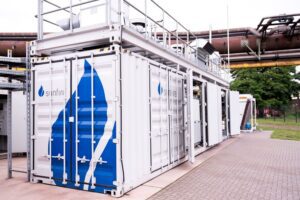Text & Images by Max-Planck-Institut für Eisenforschung GmbH
Researchers at the Max-Planck Institute have discovered a way to stop hydrogeninduced cracks in high-strength steels.
Hydrogen – the smallest of all atoms and yet becoming more and more important in terms of climate neutrality. While politics, industry and research are heading to use as much hydrogen as possible as a sustainable energy carrier, hydrogen embrittlement of high-strength alloys has become one of the major issues impeding the realization of the hydrogen economy.
These materials are urgently needed for the automotive and aerospace industry to construct lightweight structural components, and in all other components used for storing and transporting hydrogen. Scientists of the Max-Planck-Institut für Eisenforschung (MPIE) and their colleagues from the Tsinghua University China and the Norwegian University of Science and Technology, found a way to stop hydrogen-induced cracks in high-strength steels. The researchers published their latest findings in the journal Nature Materials.

Prone to hydrogen embrittlement
“Steels represent 90% of the global metallic alloy market and are at the same time particularly prone to hydrogen embrittlement. That’s why our aim was to find an inexpensive, scalable strategy to make steels more resistant to hydrogen while keeping their mechanical performance”, explains Dr. Binhan Sun, postdoctoral researcher, topic leader of Hydrogen Embrittlement in High-Performance Alloys at the MPIE and first author of the publication. The scientists implemented manganese-rich domains in the steel’s microstructure to blunt cracks and trap hydrogen inside and thus stop crack propagation. “We tested our approach with lightweight highstrength manganese steels where we produced an extremely high number density (above ~2 × 1018 m–3) of manganese-rich buffer zones.
These buffer zones represent dead ends for cracks by blunting sharp cracks. This makes the steel twice as resistant to hydrogen as conventional chemically homogeneous steels, regardless of when and how hydrogen enters the material.”, states Dr. Dirk Ponge, head of the MPIE group “Mechanism-based Alloy Design” who supervises the study.
– story continues below the photo –

Other alloys
The presented method can, in principle, be applied to over 10 established steel grades. The scientists also see possible applications for other alloys (such as multiphase titanium alloys), which need to be strong, ductile and hydrogen-resistant. However, before widening the range of alloys, the researchers are now aiming to find different methods to accurately produce domains of chemical heterogeneity inside the microstructure. These different methods could further enhance the crack-resistance effect and better fit established industrial processing routes.
About Max-Planck
The international team of the Max-Planck-Institut für Eisenforschung conducts advanced basic materials research for the fields of mobility, energy, infrastructure, medicine and digitalisation. The focus lies on nanostructured metallic materials as well as semiconductors, which are analysed down to their atomic and electronic scales. This enables the MPIE team to develop new, tailor-made structural and functional materials embracing their synthesis and processing, characterization and properties, as well as their response in engineering components exposed to real operating environments.
References
Original publication: B. Sun, W. Lu, B. Gault, R. Ding, S. K. Makineni, D. Wan, C.-H. Wu, H. Chen. D. Ponge, D. Raabe: Chemical heterogeneity enhances hydrogen resistance in highstrength steels. In: Nature Materials 2021, https://doi.org/10.1038/s41563-021-01050-y






